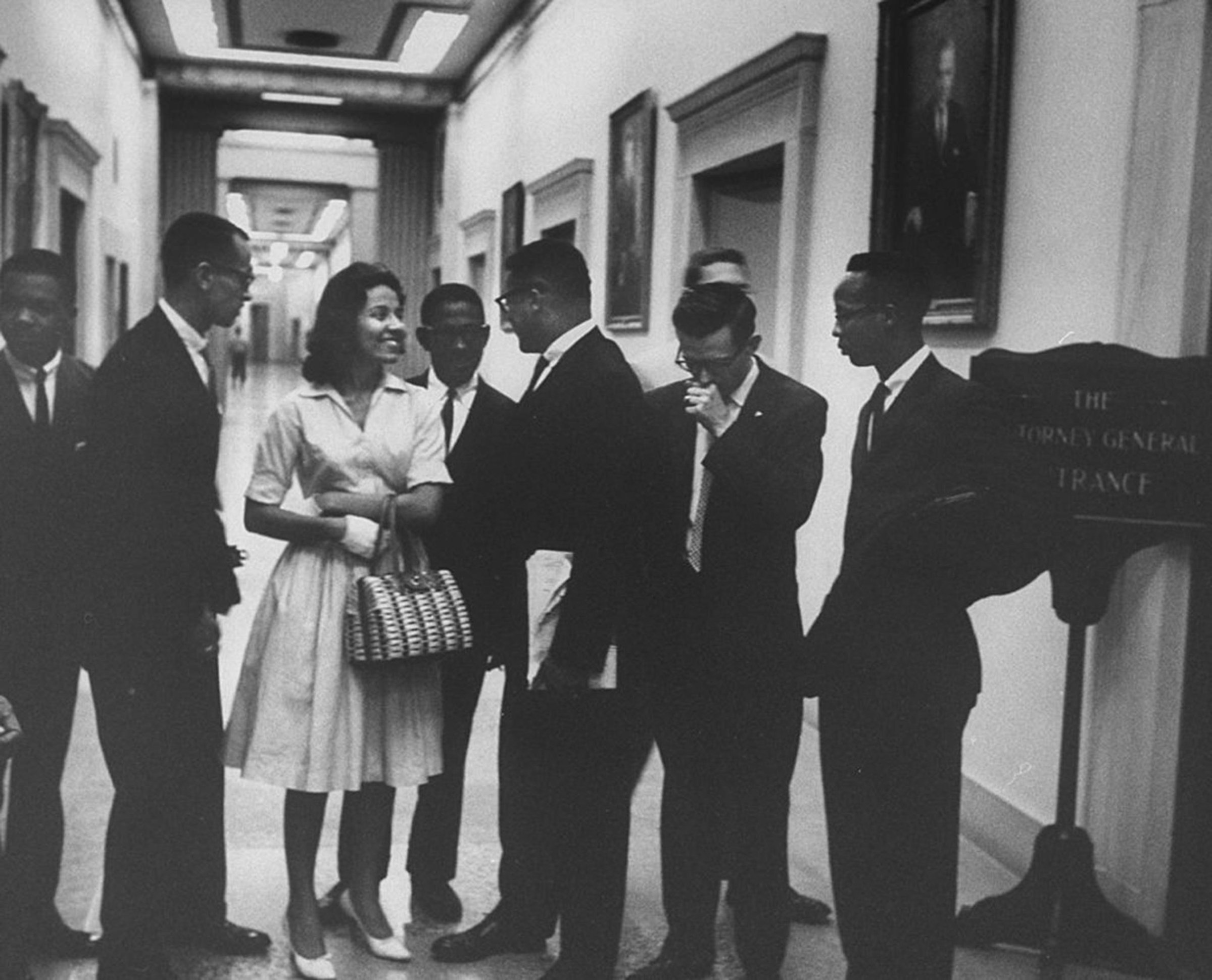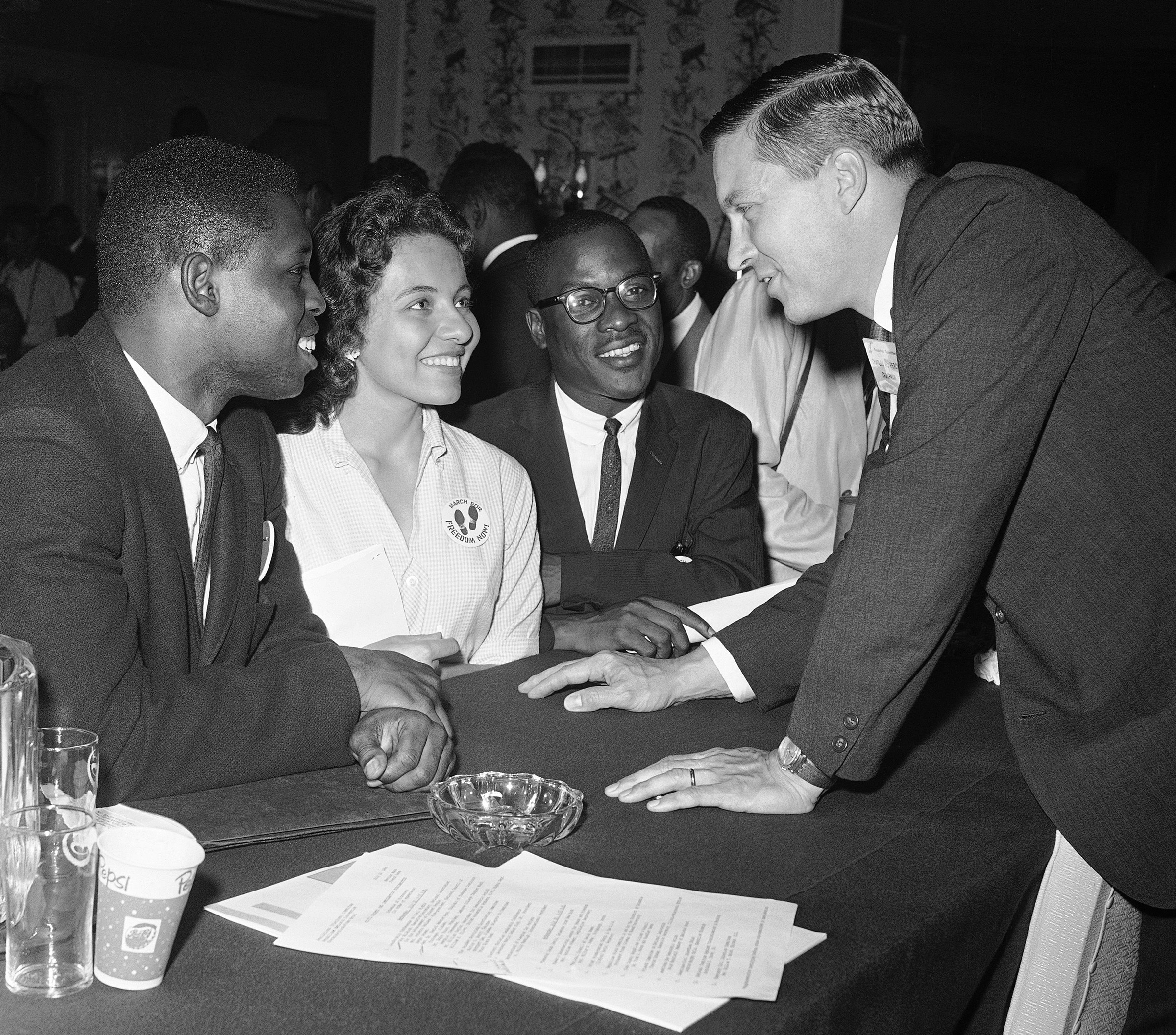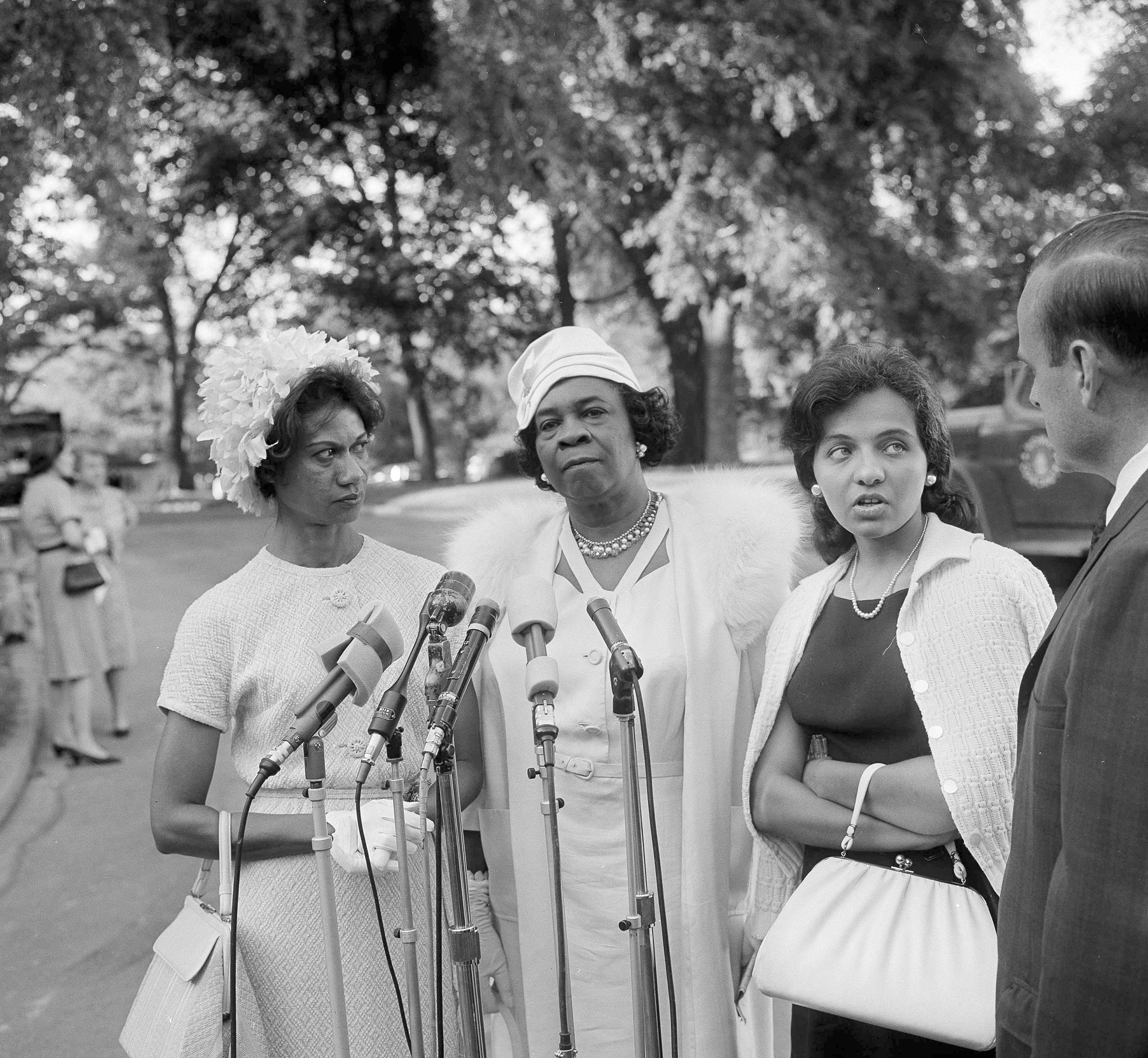
On Aug. 28, 1963, when about 250,000 people streamed toward the Lincoln Memorial at the March on Washington, in the hours before Martin Luther King Jr. would give his famous “I Have a Dream” speech, six women were invited to stand and be recognized onstage during an official “Tribute to Negro Women Fighters for Freedom.”
One of those women, listed alongside Rosa Parks and Daisy Bates, was Diane Nash Bevel. She was not there. Nash, then 25, was watching the ceremony from a motel room in Birmingham, Ala., eating room service in bed with her then-husband and fellow civil rights organizer James Bevel.
“That morning in Birmingham, when people had started to assemble to get on the buses, Bevel said to me, ‘Diane, you know, with everybody having left and gone to Washington, we could get some rest if we stayed here,’ which sounded great to me,” she recalls to TIME. “We had worked so hard recruiting people to get on the buses that we were exhausted.”
She hadn’t been told that she was going to be recognized onstage, but she saw the moment on TV.
“That was a weird feeling. I felt like reaching towards the television and saying I can’t get there,” she says.
The fact that she hadn’t been told, even despite her close involvement in the movement, is an indicator of how far removed she was from the finished event. Now, five decades later, she wants to make sure the roles of women in the movement are not forgotten.
A Leader Is Born
The Chicago native’s political awakening came in 1959 when she was a college student at Fisk University in Nashville. “I wanted to come South to see what it was really like,” Nash told TIME in 1961. Sure enough, what she saw was eye-opening: She couldn’t even get takeout at certain restaurants, and couldn’t go to the nearby public library.
“Very often people think of segregation before the civil rights movement as [meaning] you couldn’t go into restaurants and blacks had to ride at the backs of buses, but it was much more than that,” she says now. “There were daily insults. A white person could pass you and call you anything, and if you dared retaliate or say anything, you could be beaten or arrested or killed. I just felt outraged. When I was trying to learn new things, broaden my horizons, I found segregation just the opposite: limiting, constricting, confining, insulting. Every time I obeyed a segregation rule, I felt like I was agreeing that I was too inferior to use this facility or go to a front door.”

She found James Lawson‘s workshops on campus, in which he shared non-violent movement techniques he learned from Gandhi in India. Soon enough, Nash became chairperson of the Student Central Committee, which planned the 1960s sit-ins that led to Nashville becoming the first Southern city to desegregate lunch counters and public facilities. She then went on to be a co-founder of the Student Nonviolent Coordinating Committee (SNCC). Congressman John Lewis, who, back then, was a seminary student nearby and also a member of the Student Central Committee at the time, described her as “the one person who made more of an impact than anyone else on our meetings that fall” in his 1998 memoir Walking with the Wind: A Memoir of the Movement.
Martin Luther King Jr. described her in 1962 as the “driving spirit in the nonviolent assault on segregation at lunch counters.” After the Voting Rights Act of 1965 was passed, Nash received the Southern Christian Leadership Conference’s highest honor, the Rosa Parks Freedom Award. She had helped pitch the idea of the famous 1965 march from Selma to Montgomery to raise awareness about voting rights and was crucial in getting medics there when the marchers were attacked with clubs and tear gas. After Freedom Riders were attacked in Alabama on May 14, 1961, she was one of the key people who decided that the Freedom Rides must continue and who organized transportation for members of the Nashville Student Central Committee to go Alabama to finish the journey that those Freedom Riders started. She wanted to prove “you can’t stop a nonviolent campaign by inflicting violence.”
But despite the effectiveness of her work, Nash’s gender often got in the way of recognition.
As Lewis writes in his memoir, many women in the civil rights movement did not become as famous as their male peers because of the “chauvinism” of the men in the movement, which was “expressed pretty succinctly” when Stokely Carmichael infamously said that the only positions for women in the movement were “prone.” Lewis writes that he admired the way Nash stayed focused on the mission — “dead serious about what we were doing each week, very calm, very deliberate, always straightforward and sincere” — even as some men in the movement were captivated by her beauty, himself included. (“They waited years later to tell me that!” Nash jokes.)
“There were men, who, whenever there was a press conference, were right there,” she says, “while Ella Baker would be making sure everyone who came for a demonstration had a place to stay.”
Get your history fix in one place: sign up for the weekly TIME History newsletter
The March on Washington
Nash says her involvement with the 1963 March on Washington began shortly after she was arrested for trying to finish the “walk for justice” started by white postal worker William Moore, whose trek ended in Alabama when he was shot dead on April 23, 1963. Her husband, James Bevel, whom she married in 1961, came to drive her home to Birmingham after she got out of jail. She recalls that he asked her what she thought of the idea of “a national camp-out on the White House lawn” to “solidify and insist on” the movement’s goals.
She liked the idea, and got started on a meeting to talk about it, inviting attendees, finding a location, following up on the logistics. She remembers Martin Luther King Jr. attending with some of his staffers. This idea for a “camp-out” and the subsequent meeting were not the root of the 1963 March on Washington, but it captured something that was in the air at the time. The idea can be traced back to the Great Depression, when starving World War I veterans came to Washington to demand the payment of a bonus they’d been promised for their service. In 1941, labor leader A. Philip Randolph threatened to put on such a march to protest jobs discrimination against blacks in the defense industry, but stood down when President Franklin D. Roosevelt signed an executive order to create the Fair Employment Practices Commission. Randolph held onto the idea, and in the early 1960s, as the centennial of the Emancipation Proclamation approached, he brought it back to life.
Planning for what would become the March took place out of Nash’s orbit, with an organizing committee known as the “Big Six” that formed in New York City. At the time, she didn’t feel left out. She just wanted to see it come to fruition. She spread the word about the march in Birmingham at churches and at bus stops.
“Women always did a lot of [that] work,” she says, “but that was before the women’s movement and everyone’s consciousness was very low about gender, including mine.”
Unbeknownst to Nash, part of the planning for the Washington event was the organization of that “Tribute to Negro Women Fighters for Freedom.”

According to historian Jennifer Scanlon’s book Until There Is Justice, female civil rights leaders like Anna Arnold Hedgeman and Dorothy Height had been telling the Big Six and those close to them that women in the movement should be allowed to give a speech, but the men said they didn’t want to seem like they were picking favorites, which they thought would make the women jealous of one another. A week before the march, a compromise was struck: women would give no speeches and would march separately, behind the men, but A. Philip Randolph would recognize their contributions from the stage.
The plan was for a group of them to come up and take a bow. Scanlon’s book says Hedgeman suggested Nash as well as Myrlie Evers, the widow of Medgar Evers, and that the committee members chose Rosa Parks; Gloria Richardson, the head of the Cambridge Movement in Maryland; Daisy Bates, a key player in the desegregation of Little Rock Central High School; and Paris Lee, whose husband had been murdered after helping African Americans register to vote in Mississippi.
On the big day, Randolph “mistakenly announced” that Bates would be giving the women awards, but Bates instead read out a vow on behalf of those honored: “The women of this country, Mr. Randolph, pledge to you, to Martin Luther King, Roy Wilkins and all of you fighting for civil liberties, that we will join hands with you as women of this country.” Then Randolph named Evers, Nash, Richardson, and Lee. Stumbling, he asked whom he’d forgotten. Someone nudged him to say Rosa Parks.
Not everyone thought it was an adequate acknowledgement. Hedgeman and Height thought the tribute was lame. While the male leaders of the movement headed to meet President Kennedy that day, the National Council of Negro Women held a meeting the next day, to discuss the path forward for women in the movement. The name they gave their meeting was this: “After the March, What?”
Marching Forward
In a spotlight on key Freedom Riders that TIME ran in 1961, Nash told the magazine she’d thought about becoming an English teacher, but admitted, “I’ll probably be involved with this thing for the rest of my life.” And indeed, at 81, she still lectures on campuses about the civil rights movement and enjoys talking to grassroots organizers, just the way James Lawson and Ella Baker mentored her.
“No one has words you can say in a few minutes that are going to change history,” she says. “Gandhi invented a process for how to bring about social change, and protest is about 20% of that. There’s a philosophy and specific steps and phases. Young people now are doing what they saw on television, the pickets and the demonstrations. I was in training for four months, and other people longer than that, before we ever had a demonstration.”
Looking at today’s young organizers, she also worries about hasty decisions to boycott something, and the possibility that boycotts that don’t lead to concrete wins might discourage future participation. She worries about the #MeToo-era question of how to judge the noble deeds of a person who has done ignoble things. (That one hits close to home: In 2008, Bevel, the civil-rights leader who was her ex-husband by then, was convicted on incest charges and died shortly after being sentenced to 15 years in prison. “I think that people should be accountable for negative things that they do, and I think he was held accountable, he was convicted,” she says. “And they should be given credit for the positive things that they do.”) She also worries that, in commemorating historical anniversaries, nostalgia can soften some of the harder realities of history’s biggest moments.
She recalls the irony of watching events marking the 50th anniversary of the March on Washington, once again from afar, and seeing politician after politician speak. “In the original March on Washington, we did not have politicians as speakers. That was the movement’s chance to tell the politicians what they needed to do. When you have politicians doing the main speaking, it indicates you don’t have much of a movement.”
Now, five decades later, she regrets not being at the original March on Washington to be recognized onstage.
“A lady called me and said she had a physical award for me, and that I could get it whenever I wished, and I regret now that I never went to get it,” she says. “If somebody knows where it is, I would love to know. And this time, I would come and get it.”
More Must-Reads From TIME
- The 100 Most Influential People of 2024
- Coco Gauff Is Playing for Herself Now
- Scenes From Pro-Palestinian Encampments Across U.S. Universities
- 6 Compliments That Land Every Time
- If You're Dating Right Now , You're Brave: Column
- The AI That Could Heal a Divided Internet
- Fallout Is a Brilliant Model for the Future of Video Game Adaptations
- Want Weekly Recs on What to Watch, Read, and More? Sign Up for Worth Your Time
Write to Olivia B. Waxman at olivia.waxman@time.com